Consumers - 15 Important Tips Before You Purchase a Toilet
Before you ever leave the house to shop for a toilet, get out your tape measure and gather the information you will need!
MaP-Testing is an independent and voluntary testing program for toilet models. MaP (Maximum Performance) Scores represent the number of grams of solid waste (soybean paste and toilet paper) that a toilet model can flush and remove completely from the fixture in a single flush. Manufacturer participation in MaP is not mandatory or regulated.
Tip #1
Rough-in
Know the rough-in dimension of your toilet installation. The distance from the flange bolts (that anchor your bowl to the floor, usually covered by small plastic caps) to the wall behind your toilet is known as the rough-in. In most North American homes that dimension is either 10, 12, or 14 inches, the most common in today’s homes being 12 inches.
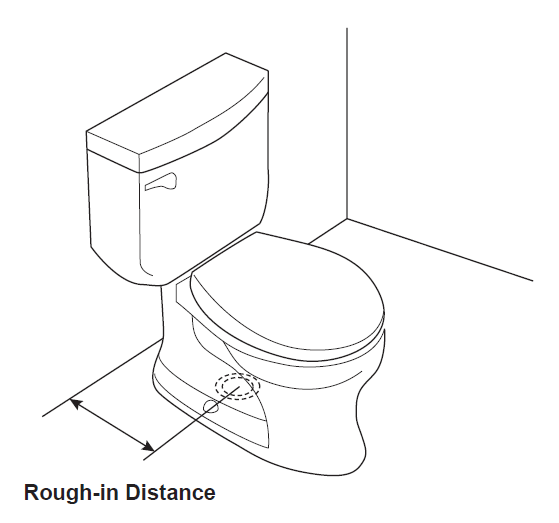
Tip #2
Bowl Height
The distance from the floor to the top rim of the bowl (not including the toilet seat). In North America, that distance has traditionally been about 14 to 15 inches. However, the trend for many families today is to install bowls with a height of 16 to 18 inches. Manufacturers use terms such as “Comfort Height”, “Chair Height”, “Easy Height”, “Right Height”, “Highboy”, “Smart Height”, “ADA Height”, or some other similar description. The added height makes getting on and off the bowl easier, especially for the elderly or infirm, but many younger persons have also discovered the benefits. Decide whether or not you want a toilet with a taller bowl.
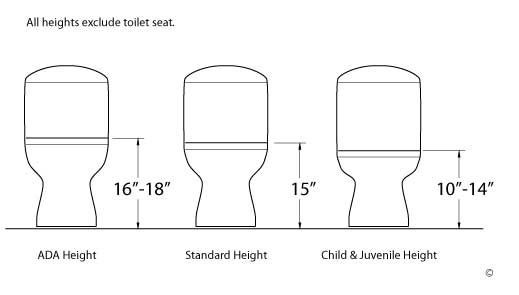
Tip #3
One-Piece vs.
Two-Piece
Two-piece toilets are the most common design found in homes today. They are typically less expensive and usually have a taller tank. One-piece toilets, on the other hand, are generally more expensive but they are often easier to clean and may provide a smoother or sleeker appearance. Decide on one-piece or two-piece.

Tip #4
Footprint
If you are replacing an existing toilet that has a large footprint (i.e., the base covers a large floor area), consider the patching and repair to the floor that might be required if a bowl with a smaller footprint is chosen. This is especially an issue where ceramic tile covers the floor around the toilet. Will additional matching tile be required and will the appearance be satisfactory? Footprint dimensions of most new toilets may be found on the manufacturers’ websites.

Tip #5
Wall-Print
If you are replacing an older toilet that has a large tank AND the wall area that is hidden behind that tank is unfinished or unpainted, consider that the installation of a smaller tank (typical of many of today’s toilet models) may leave those unpainted areas visible. As such, you may be required to repaint a portion of the wall or even the entire bathroom.
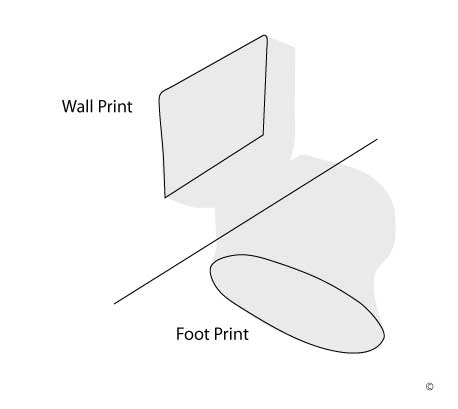
Tip #6
Bowl Shape
Choosing the right bowl design is an important factor. Bowls typically have either a rounded front or an elongated front, though “special shape” bowls are also available. Round-front bowls are smaller and, therefore, are ideal for compact bathroom spaces. Elongated bowls are as much as 2-inches longer, they are considered more comfortable for adult use, and they help improve hygiene. Be sure to measure the dimensions of your existing bowl and consider the size of the toilet space in your bathroom before replacing a round-front model with an elongated model. There have been cases where doors and drawers could not be opened when the old round front bowl was replaced with an elongated model! Check manufacturer websites for the dimensions of bowls and tanks. Decide on the bowl shape.
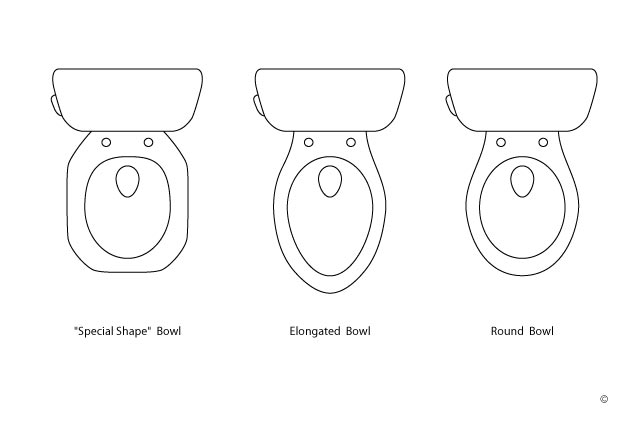
Tip #7
Water Shut-Off
Valve and
Supply Hose
Check the condition of your existing shut-off valve (called the ‘angle stop’) that supplies water to the toilet and the supply hose connecting that valve with your toilet tank. If you need to replace the supply hose, consider one encased in stainless steel mesh for long-term durability. If the shut-off valve needs replacing, it may be necessary to call your plumber.
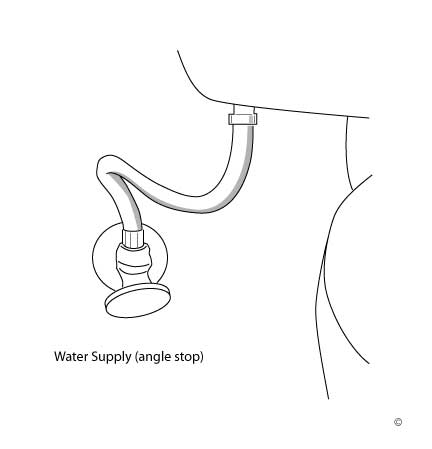
Tip #8
Flush Handle
Location
Manufacturers place flush handles at various locations on the tank: right side, right front, left side, left front, and at the top-center of the tank lid. You should determine if the handle’s location is important.
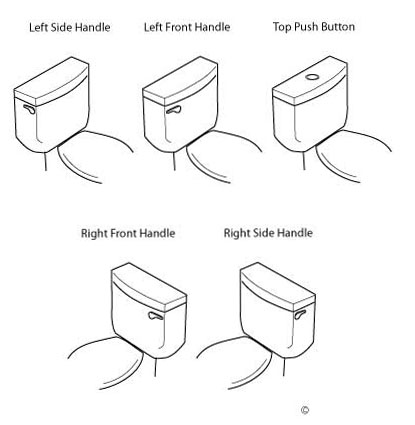
Tip #9
"Banjo Top"
Issues
Sometimes a fixed shelf (called a “banjo top” counter) is installed directly above a toilet (see illustration below). If you have a “banjo top” counter, be sure to measure the distance from the floor to the shelf and choose a toilet that leaves sufficient room between the tank lid and the shelf such that the lid can be removed and the parts inside the tank can be accessed when required.
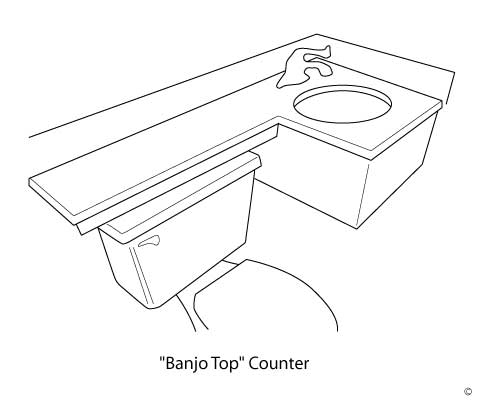
Tip #10
Insulated Tank
In humid climates or buildings without air conditioning, sweating and dripping toilet tanks can be a problem. As cold water refills the tank after a flush, condensation can form on the outside of the tank and drip on the floor. This problem is far more common in older high flush volume toilets where the tank totally empties and refills each flush cycle. Most water-efficient toilet models do not completely empty the tank during a flush cycle, so the risk of condensation is far lower. If you have issues with condensation, there are two readily available solutions: choose a pressure-assist model where the water is contained within a separate pressure vessel inside the toilet tank (see Tip #12) OR choose a model with an insulated tank where the insulation (generally styrofoam) keeps the cold water from contacting the tank walls.
Tip #11
Wall-Mounted
Toilets
Wall Mounted: Entire fixture is affixed to the wall and the entire weight of the bowl and tank are born by a carrier structure in the wall.
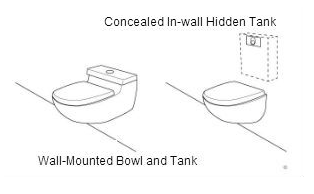
Tip #12
Flush Type
Gravity Fed: Fixtures that only use gravity (weight of the water in the tank) as the source of energy for flushing.
Pressure Assist: Fixtures that use the potential energy in the building’s pressurized water line to compress air within a containment vessel inside the toilet tank. Compressed air behind the water provides a more vigorous flushing action than the gravity fed.
Vacuum Assist – Fixtures that create a low level of vacuum (negative air pressure) to assist with the flushing action.

Tip #13
MaP Score
If you want a toilet with the best flush performance, you MUST check the MaP scores! Go here to do a search for just the right toilet to meet your needs: https://www.map-testing.com/map-search/
Remember that toilets with scores of 500 and above will provide you with excellent performance.
Tip #14
Color
Generally, a colored toilet can be a disadvantage, particularly if choosing a trendy color requires you to also replace the bathroom lavatory sink and the tub in order to maintain continuity. In addition, when its time to sell your home, today’s ‘popular’ color may be tomorrow’s albatross. We recommend sticking with white or off-white (sometimes referred to as biscuit or beige or bone), all of which are commonly found in homes today.
Tip #15
Cost
Presumably the toilet you choose will be installed and operating for at least 25 years. Don’t attempt to save a few dollars on a toilet purchase when you are making an ‘investment’ in your home that will have lasting functionality and use. Also note that flush performance and user satisfaction are not directly related to what you paid for the toilet. In fact, some of the best performing toilets are also the least expensive; and some of the most expensive are only marginal when it comes to performance.
